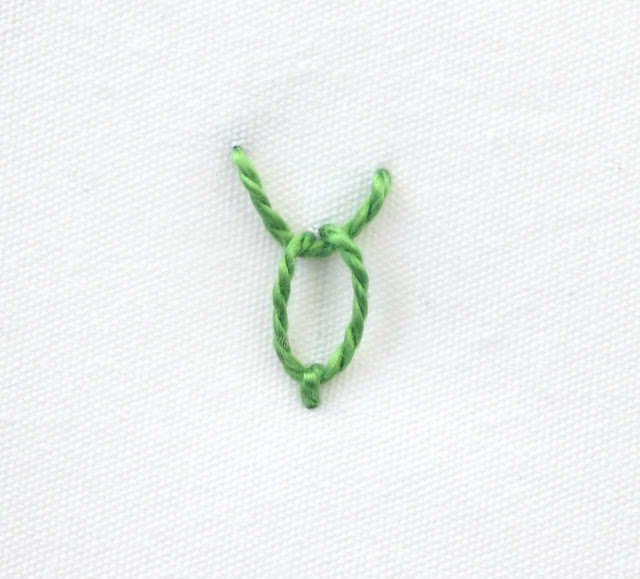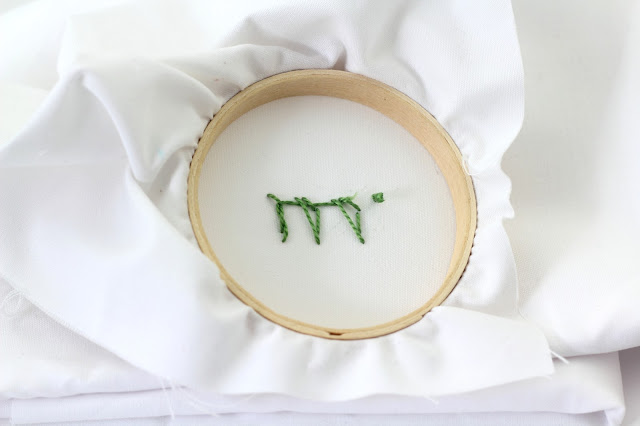skip to main |
skip to sidebar
The latest stitch on my 100 Stitches Plus list is this beautiful Russian Chain Stitch.
For my demonstration, I am using this perle cotton thread - DMC Color Variations #4025.
The Russian Chain Stitch is made up of three Lazy Daisy Stitches that are grouped together. The first Lazy Daisy is a vertical stitch:
The next Lazy Daisy is done at a diagonal:
and the third is done at an opposite diagonal:
From the description this seems really easy to do doesn't it?
Well I found it really hard to keep all of my Lazy Daisy Stitches the same size.
After some trial and error, I drew guidelines on the fabric with a water soluble marking pen.
My guidelines are a bit hard to see but I measured three parallel lines at 1/4" apart.
I would definitely recommend guidelines - I was able to make a whole row of stitches that look really even in size and shape:
I found this stitch in the book Embroidery Stitches by Mary Webb. She noted that this stitch may be done in horizontal rows or in vertical columns. In either case, the first Lazy Daisy Stitch should be pointing upwards.
I have a new hand embroidery pattern set in my shop!
This one is called Country Kitchen. The set is filled with charming country motifs.
The motifs are perfect for embellishing linens in a country or farmhouse themed kitchen.
I have started two projects from this pattern set. The first is this rooster cock-a-doodle-doodling at sunrise. I don't know if you can see the text that I have outlined it says "Rise and Shine".
This is a good sized motif about 9-1/2" x 6". For this picture I had to use the largest hoop I have, a 12"!
The second project is a flower bouquet in a tin can:
This will be a quick project since all the flowers are Lazy Daisy Stitches :)
I have a few more projects that I am transferring to fabric, I will be sure to post my progress.
I finished the embroidery on the back pillow panel. You can read about this project here: {Part 1} and here: {Part 2} .
I am really pleased with this back panel, both with the color palette and the variety of stitches I used.
The green plant in the center has Fishbone Stitch leaves and a Stem Stitch stem. The two burnt orange colored plants are done in Back Stitch and French Knots. The two green plants on the outer edges have Stem Stitch stems, Lazy Daisy Stitch leaves with Straight Stitch centers:
Here are the front and back panels side by side so that you can see how well they go together:
I still need to iron both panels, select a nice trim for the pillow edges and make the pillow.
For now, I am recording all of my colors and stitches to include in my Embroidery Journal:
This stitch is called Tete de Boeuf or Head of the Bull. It is a composite stitch, made from a Fly Stitch {for the horns}and a Lazy Daisy Stitch {for the head}.
I am adding this stitch to my 100 Stitches Plus list and I want to share the steps I learned:
The first step is to create the horns using the Fly Stitch.
I came up through the fabric:
pulled the thread all the way through and towards the right:
I brought the needle around and went back into the fabric to the right of where the thread first emerged. Keep in mind that how far to the right determines how wide the horns will be:
I came back out of the fabric halfway between and a little below the first two holes. Notice my needle is going to pass over the working thread to create a loop:
I gently pulled the thread all the way through. Normally you would now go back into the fabric right under the loop to form the Fly Stitch but now it is time to make the bull's head with a Lazy Daisy Stitch.
I brought the needle back around and went into the fabric just to the right of where my thread just emerged:
Then I brought my needle back out of the fabric a distance below the horns - how far below will determine the size of the bull's head. Notice, my needle is going to pass over the working thread to form a loop:
Gently pulled all the way through:
Next I secured the stitch by going back into the fabric just below the loop:
I buried my thread on the underside:
I am not sure where I would use this stitch. I have been experimenting with it and it does looks nice done in a row:
I learned this stitch from the book Elegant Stitches by Judith Baker Montano.




















































